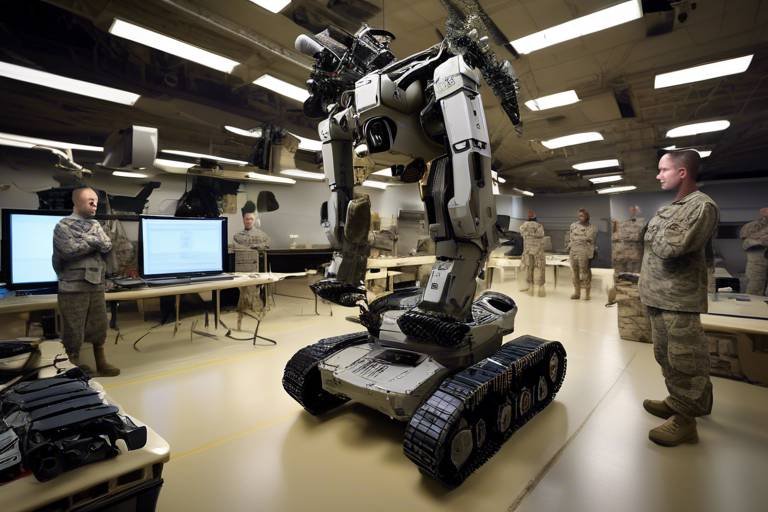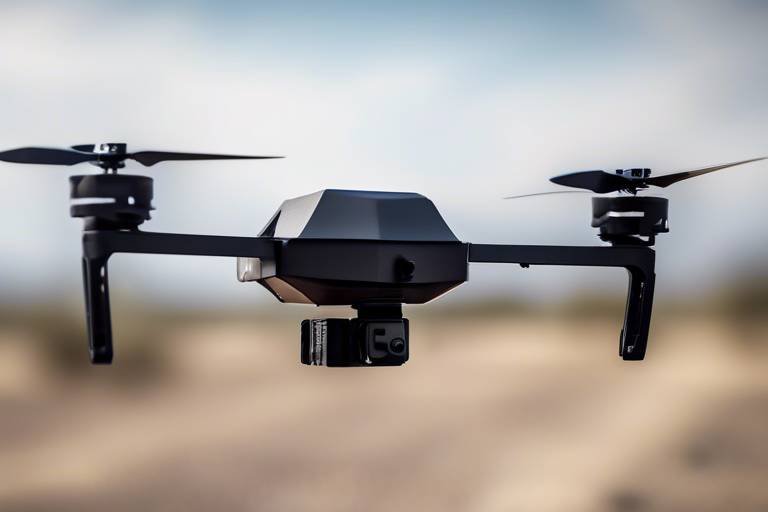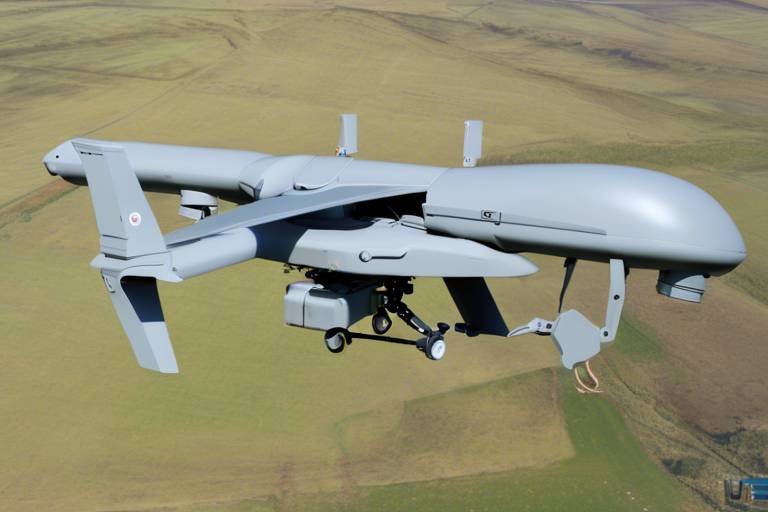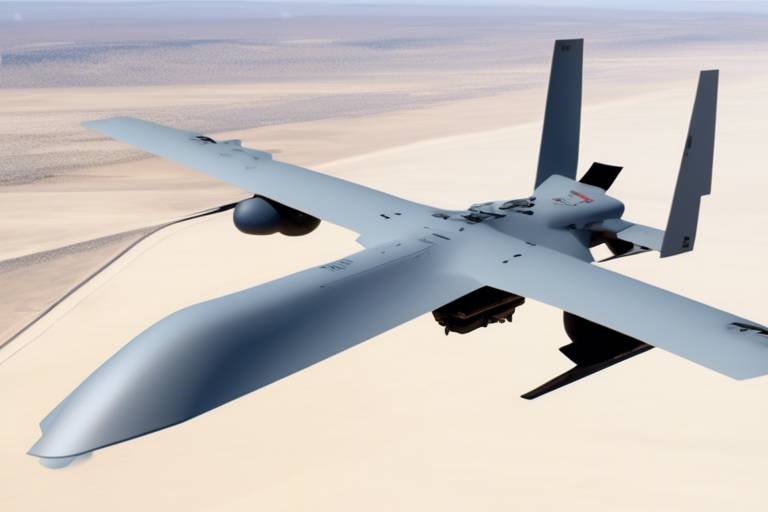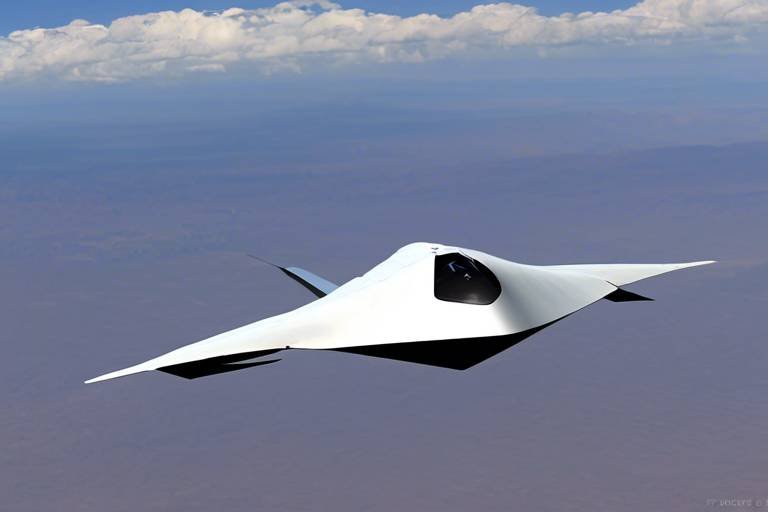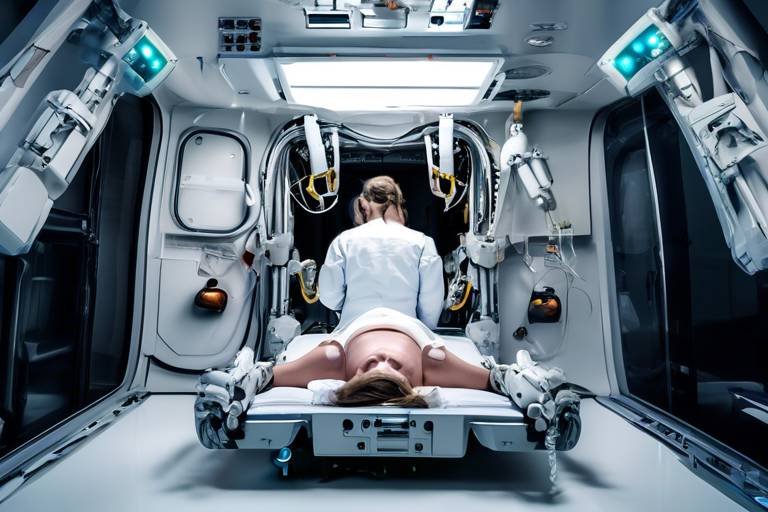Assessing the Applications of the Warfighter Robotic System in Military
The landscape of modern warfare is rapidly evolving, and at the forefront of this transformation is the Warfighter Robotic System. These advanced robotic systems are designed to enhance military operations, providing a blend of efficiency, safety, and cutting-edge technology. Imagine a battlefield where soldiers can deploy unmanned vehicles to gather intelligence, defuse bombs, or even engage in combat, all while minimizing their own risk. This is not science fiction; it is the reality of contemporary military strategy.
The applications of warfighter robotic systems are as diverse as they are impactful. From reconnaissance missions to logistics support, these systems are reshaping how military forces operate. With the integration of artificial intelligence and machine learning, these robots can process vast amounts of data, making them invaluable for decision-making in high-stakes environments. The ability to analyze real-time data and adapt to changing conditions is a game changer, allowing for more strategic and informed responses to threats.
Moreover, the benefits of employing robotic systems in combat scenarios are substantial. One of the most significant advantages is the reduction of risk to human soldiers. By deploying robots for dangerous tasks, military personnel can focus on strategy and execution without the constant fear of losing lives in the line of duty. This shift not only enhances the safety of troops but also improves overall operational efficiency.
However, the implementation of these systems is not without its challenges. Technical limitations, the need for seamless integration with existing military infrastructure, and ethical concerns surrounding autonomous decision-making in combat situations present hurdles that must be addressed. As we delve deeper into the applications of warfighter robotic systems, it becomes clear that while the potential is vast, careful consideration and planning are essential to harness their full capabilities.
- What are warfighter robotic systems?
Warfighter robotic systems are advanced machines designed to assist military personnel in various operations, including reconnaissance, logistics, and combat.
- How do robotic systems enhance situational awareness?
These systems provide real-time data and surveillance capabilities, allowing commanders to make informed decisions swiftly.
- What challenges do military robotic systems face?
Challenges include technical limitations, integration with existing infrastructure, and ethical concerns regarding autonomous decision-making.
- What is the future of military robotics?
The future trends include advancements in AI, machine learning, and the development of fully autonomous systems that may reshape warfare.

Overview of Warfighter Robotic Systems
This article explores the various applications of robotic systems in military operations, focusing on their effectiveness, challenges, and future potential in enhancing combat capabilities and safety for personnel.
The landscape of modern warfare is rapidly changing, and at the forefront of this evolution are Warfighter Robotic Systems. These systems are designed to perform a variety of tasks that enhance the operational capabilities of military forces. From reconnaissance missions to logistical support, the applications of these robotic systems are vast and varied. The primary purpose of these systems is to increase efficiency while simultaneously reducing risks to human soldiers. Imagine having a robotic companion that can scout enemy positions or deliver supplies to troops in danger; this is not science fiction, but rather a reality that is unfolding before our eyes.
Technological advancements have played a pivotal role in shaping the development of warfighter robotic systems. Innovations in artificial intelligence (AI), machine learning, and sensor technology have enabled these systems to operate with increased autonomy and effectiveness. For instance, modern robotic systems are equipped with sophisticated sensors that allow them to navigate complex environments, gather intelligence, and even perform tasks that were previously thought to be the sole domain of human soldiers.
To give you a clearer picture, let's consider some key features that define these systems:
- Autonomy: Many warfighter robotic systems can operate independently, making real-time decisions based on their programming and environmental inputs.
- Versatility: These systems can be adapted for various missions, from surveillance to explosive ordnance disposal.
- Collaboration: Robotic systems are designed to work alongside human soldiers, enhancing their capabilities rather than replacing them.
Moreover, the integration of advanced robotics into military operations has been influenced by the increasing complexity of combat scenarios. As warfare evolves, the need for systems that can provide real-time data and support decision-making becomes paramount. The ability to deploy robotic systems in high-risk environments not only protects human lives but also enhances the overall effectiveness of military operations.
In summary, warfighter robotic systems represent a significant leap forward in military technology. Their design and purpose are not just about replacing human effort but about augmenting it, providing a strategic advantage that is crucial in today’s fast-paced and unpredictable battlefield. As we delve deeper into the benefits and challenges of these systems, it becomes evident that they are not merely tools but essential components of future military strategies.
Robotic systems offer numerous advantages in combat scenarios, including improved reconnaissance, reduced risk to human soldiers, and enhanced operational efficiency, which are crucial for modern warfare strategies.
Robotic systems significantly improve situational awareness on the battlefield by providing real-time data and surveillance capabilities, enabling commanders to make informed decisions and respond swiftly to threats.
The integration of advanced sensors and AI allows robotic systems to collect and analyze vast amounts of data, leading to better strategic planning and execution during military operations.
Remote operation capabilities enable soldiers to control robotic systems from a safe distance, minimizing exposure to danger while maintaining operational effectiveness in hostile environments.
Despite their advantages, implementing warfighter robotic systems presents challenges, including technical limitations, integration with existing military infrastructure, and ethical considerations regarding autonomous decision-making in combat.
This section examines emerging trends in military robotics, such as advancements in AI, machine learning, and autonomous systems, which are poised to reshape the future of warfare and military operations.
The development of fully autonomous systems is on the rise, promising to enhance operational capabilities but raising questions about accountability and control in combat situations.
Successful integration of robotic systems with human forces is critical for maximizing their effectiveness, requiring training, collaboration, and clear communication to ensure seamless operations on the battlefield.
- What are warfighter robotic systems?
Warfighter robotic systems are advanced technological tools designed to assist military operations, performing tasks ranging from reconnaissance to logistics.
- How do these systems enhance combat effectiveness?
They improve situational awareness, reduce risks to personnel, and increase operational efficiency through real-time data collection and analysis.
- What challenges do military robotic systems face?
Challenges include technical limitations, integration with existing systems, and ethical considerations regarding autonomous decision-making.

Benefits of Robotic Systems in Combat
The integration of robotic systems into military combat scenarios has revolutionized the way modern warfare is conducted. Imagine a battlefield where soldiers are not the only ones taking risks; instead, they have advanced machines at their disposal that can scout, engage, and even extract valuable data, all while keeping human personnel safe. This innovative approach offers a multitude of benefits that enhance both operational efficiency and strategic advantage.
One of the most significant advantages of robotic systems is their ability to perform reconnaissance missions with unparalleled precision. Equipped with advanced sensors and cameras, these robots can gather real-time intelligence, allowing military commanders to make informed decisions quickly. For instance, consider a drone flying over enemy territory, capturing high-definition images and transmitting them back to the command center. This capability not only saves time but also minimizes the risk of human casualties in dangerous reconnaissance missions.
Another crucial benefit is the reduced risk to human soldiers. In traditional combat scenarios, soldiers often face life-threatening situations while trying to gather information or engage the enemy. Robotic systems can take on these dangerous tasks, effectively acting as a shield for human troops. This is particularly valuable in urban warfare or environments where the threat level is unpredictable. By deploying robots to assess threats or clear pathways, military forces can significantly decrease the likelihood of injuries or fatalities among their personnel.
Moreover, robotic systems enhance operational efficiency by streamlining various military operations. For example, logistics and supply chain management can be optimized using automated vehicles that transport supplies to remote locations without putting human lives at risk. This not only speeds up the process but also ensures that troops receive the necessary resources when they need them the most. The versatility of these systems allows them to perform a wide range of tasks, from bomb disposal to medical evacuation, showcasing their adaptability in various combat scenarios.
Robotic systems also contribute significantly to enhanced situational awareness on the battlefield. By providing commanders with real-time data and surveillance capabilities, these systems enable military leaders to respond swiftly to emerging threats. The integration of advanced sensors allows for comprehensive monitoring of the battlefield, making it easier to detect enemy movements and assess potential risks. With the ability to analyze data on the fly, commanders can make split-second decisions that could mean the difference between victory and defeat.
The incorporation of artificial intelligence (AI) and machine learning algorithms into robotic systems takes data collection and analysis to the next level. These technologies allow robots to process vast amounts of information quickly, identifying patterns and trends that human analysts might miss. This capability leads to better strategic planning and execution during military operations, as decisions can be based on accurate, data-driven insights rather than gut feelings or incomplete information.
Another remarkable feature of robotic systems is their remote operation capabilities. Soldiers can control these machines from a safe distance, minimizing their exposure to danger while maintaining operational effectiveness in hostile environments. This is akin to playing a video game where the player controls a character in a high-risk situation without being physically present. Such technology not only enhances safety but also allows for more flexible and adaptive responses to changing battlefield conditions.
In summary, the benefits of robotic systems in combat are profound and multifaceted. From improving reconnaissance and reducing risks to enhancing operational efficiency and situational awareness, these technologies are reshaping the landscape of military operations. As we look to the future, it's clear that the role of robotics in warfare will only continue to expand, paving the way for safer and more effective combat strategies.
- What are warfighter robotic systems?
Warfighter robotic systems are advanced machines designed to assist military forces in various operations, enhancing their capabilities while reducing risks to human personnel. - How do robotic systems improve reconnaissance?
Robotic systems equipped with sensors and cameras can gather real-time intelligence, allowing for quicker and safer reconnaissance missions. - What are the risks associated with using robotic systems in combat?
While robotic systems significantly reduce risks to human soldiers, challenges such as technical malfunctions and ethical concerns regarding autonomous decision-making remain. - How will robotics shape the future of warfare?
Advancements in AI and machine learning are expected to enhance the capabilities of robotic systems, leading to more effective and strategic military operations.

Enhanced Situational Awareness
In the chaotic environment of modern warfare, situational awareness is not just a luxury; it’s a necessity. Robotic systems have emerged as game-changers in this realm, providing military personnel with a clearer, more comprehensive view of the battlefield. Imagine a soldier navigating through a dense forest, where every rustle of leaves could signal an ambush. Now, picture that soldier equipped with a robotic system that can scout ahead, relay real-time data, and identify potential threats long before they become dangerous. This is the power of enhanced situational awareness through robotics.
Robotic systems, equipped with advanced sensors and surveillance technology, can gather critical information from various sources. These systems can operate in environments that are too dangerous for human soldiers, such as contaminated zones or areas with high enemy activity. By utilizing drones and ground robots, military forces can access real-time data that is essential for making informed decisions. This capability not only saves lives but also enhances strategic planning.
For instance, consider the integration of AI-driven analytics into these robotic systems. They can process vast amounts of data collected from the battlefield, such as troop movements, terrain changes, and potential hazards. This data analysis leads to actionable insights, allowing commanders to adapt their strategies on-the-fly. The result? A more agile and responsive military force that can outmaneuver opponents.
Moreover, the use of robotic systems for reconnaissance can significantly reduce the time it takes to gather information. Traditional reconnaissance methods can be slow and risky. In contrast, a robotic system can traverse the terrain, capture high-resolution images, and transmit that data back to command centers almost instantaneously. This rapid feedback loop is crucial for maintaining an edge in combat situations.
To illustrate the impact of enhanced situational awareness, consider the following table that outlines the key benefits provided by robotic systems in military operations:
| Benefit | Description |
|---|---|
| Real-time Data Collection | Robotic systems can gather and transmit data instantly, allowing for quick decision-making. |
| Risk Mitigation | Deploying robots in dangerous areas reduces the risk to human soldiers. |
| Improved Analysis | AI capabilities enhance the ability to analyze complex situations and predict outcomes. |
| Operational Efficiency | Faster data collection leads to quicker responses, improving overall military efficiency. |
In conclusion, the integration of robotic systems into military operations is revolutionizing situational awareness. By providing real-time data, enhancing analysis, and reducing risks, these systems empower soldiers to navigate the complexities of modern warfare with greater confidence and effectiveness. As technology continues to advance, the potential for even greater enhancements in situational awareness is on the horizon, promising a future where military operations are not only safer but also smarter.
- What are warfighter robotic systems? Warfighter robotic systems are advanced technologies designed to assist military personnel in various operations, enhancing their capabilities and safety.
- How do robotic systems improve situational awareness? They provide real-time data collection, advanced surveillance, and analytical capabilities, allowing for quick and informed decision-making on the battlefield.
- What challenges do robotic systems face in military applications? Challenges include technical limitations, integration with existing systems, and ethical concerns regarding autonomous decision-making.
- What is the future of military robotics? The future includes advancements in AI and machine learning, leading to more autonomous systems and better integration with human forces.

Data Collection and Analysis
The integration of advanced sensors and artificial intelligence (AI) in warfighter robotic systems has revolutionized the way data is collected and analyzed in military operations. Imagine a battlefield where every movement, every sound, and every potential threat is monitored in real-time by an array of robotic units equipped with state-of-the-art technology. These systems act as the eyes and ears of military commanders, providing a level of situational awareness that was unimaginable just a few decades ago.
Robotic systems are designed to gather vast amounts of data, from environmental conditions to troop movements, and then process this information to create actionable insights. For instance, drones equipped with high-resolution cameras and thermal imaging can scout enemy positions without putting human lives at risk. This data is then analyzed using sophisticated algorithms, allowing military strategists to make informed decisions based on accurate, real-time intelligence.
Moreover, the ability to collect and analyze data extends beyond simple surveillance. With the help of machine learning, these systems can identify patterns and predict potential threats before they materialize. This predictive capability is akin to having a crystal ball in the chaos of warfare, enabling commanders to anticipate enemy actions and adjust their strategies accordingly.
To illustrate the impact of data collection and analysis by robotic systems, consider the following table:
| Data Type | Source | Analysis Purpose |
|---|---|---|
| Environmental Data | Weather Sensors | Optimize mission planning |
| Troop Movement | Surveillance Drones | Identify enemy positions |
| Communication Signals | Signal Interceptors | Intercept enemy communications |
| Terrain Mapping | Ground Robots | Plan tactical movements |
These robotic systems not only enhance the quality of intelligence but also speed up the decision-making process. In the fast-paced environment of modern warfare, time is often of the essence. The quicker commanders can analyze data and respond to threats, the higher the chances of mission success. However, it’s essential to remember that while technology can provide incredible advantages, it is the human element that ultimately drives military strategy. The data collected is only as good as the decisions made based on it.
In conclusion, the role of data collection and analysis in warfighter robotic systems cannot be overstated. These technologies are transforming the battlefield into a more informed and strategic environment, where data-driven decisions can mean the difference between victory and defeat. As military operations continue to evolve, the synergy between human intelligence and robotic data analysis will be crucial in shaping the future of combat.
- What are warfighter robotic systems?
Warfighter robotic systems are advanced robotic technologies designed to assist military personnel in various operations, including reconnaissance, combat support, and logistics.
- How do robotic systems improve situational awareness?
These systems provide real-time data and surveillance capabilities, allowing commanders to make informed decisions based on current battlefield conditions.
- What challenges do military robotic systems face?
Challenges include technical limitations, integration with existing infrastructure, and ethical concerns regarding autonomous decision-making in combat scenarios.
- What is the future of military robotics?
The future includes advancements in AI, machine learning, and the development of fully autonomous systems, which will reshape military operations.

Remote Operation Capabilities
In the rapidly evolving landscape of military strategy, have emerged as a game-changer for warfighter robotic systems. Imagine being able to control a sophisticated robot from hundreds, if not thousands, of miles away! This not only minimizes the risk to soldiers on the front lines but also ensures that they can carry out their missions effectively and efficiently. With the integration of advanced communication technologies, operators can engage in combat scenarios without being physically present, thus transforming the way military operations are conducted.
The essence of remote operation lies in its ability to provide a safe distance between human operators and potential threats. This is particularly crucial in environments where traditional forces may face overwhelming odds or where the risk of casualties is significantly high. For example, consider a scenario where a robotic unit is deployed to defuse explosives or gather intelligence in hostile territory. The operator can control the robot from a secure base, significantly reducing the chances of injury or death.
Moreover, the technology behind remote operation has advanced tremendously, incorporating features like real-time video feeds and sensor data that allow operators to make informed decisions on the fly. This capability not only enhances situational awareness but also ensures that the robotic systems are utilized to their full potential. Operators can manipulate the robots' movements, adjust their sensors, and even make tactical decisions based on the information received.
However, with great power comes great responsibility. There are several factors to consider when implementing remote operation capabilities:
- Latency: The time it takes for commands to be sent and executed can impact the effectiveness of remote operations.
- Training: Operators must be thoroughly trained to handle the technology and make quick decisions under pressure.
- Cybersecurity: Protecting the communication channels from enemy interference or hacking is paramount.
As military forces continue to invest in these technologies, the potential applications seem limitless. From reconnaissance missions to direct engagement in combat, the ability to operate robotic systems remotely is not just a trend; it's a crucial evolution in how we approach warfare. The future of military operations will likely see even more sophisticated systems that can autonomously navigate complex environments while being remotely supervised by trained personnel.
- What are the main advantages of remote operation in military robotics? Remote operation allows soldiers to engage in combat without being physically present, reducing risks to personnel and enhancing operational effectiveness.
- How does real-time data enhance remote operations? Real-time data provides operators with critical information that aids in decision-making, ensuring that missions are executed with precision and accuracy.
- What challenges do military forces face when implementing remote operation capabilities? Challenges include latency issues, the need for extensive operator training, and ensuring cybersecurity to protect against potential threats.

Challenges in Implementation
Implementing warfighter robotic systems in military operations is not without its hurdles. While the potential benefits are immense, several challenges can impede their effective deployment. One of the most significant issues is the technical limitations of current robotic technologies. These systems often struggle with complex terrains and unpredictable environments, which can lead to operational failures. Imagine trying to navigate a rugged battlefield with a drone that can’t handle sudden changes in elevation or obstacles—frustrating, right?
Moreover, there’s the challenge of integrating these advanced systems with existing military infrastructure. Many military units are accustomed to traditional methods of combat and communication, and introducing robotics requires a shift in mindset and training. This transition can be slow and costly, as it demands not only new equipment but also new protocols and strategies. It’s like trying to teach an old dog new tricks; the resistance to change can be significant.
Another critical aspect is the ethical considerations surrounding autonomous decision-making in combat. As robotic systems become more advanced, the question of accountability surfaces. If an autonomous drone makes a mistake that results in civilian casualties, who is responsible? This moral dilemma adds layers of complexity to the implementation of robotic systems. The military must grapple with these ethical implications while ensuring operational effectiveness.
Additionally, there are concerns about cybersecurity. As robotic systems become more interconnected and reliant on data, they become vulnerable to hacking and other cyber threats. A compromised system could lead to catastrophic failures on the battlefield. The military must invest in robust cybersecurity measures to protect these technologies from potential attacks.
Finally, the cost of developing, deploying, and maintaining robotic systems can be prohibitive. Budget constraints often limit the extent to which military organizations can pursue advanced technologies. This financial burden can delay the integration of robotic systems and limit their capabilities in critical situations. To summarize, the challenges in implementing warfighter robotic systems are multifaceted and require careful consideration and strategic planning to overcome.
- What are the primary challenges faced in implementing robotic systems in the military?
Technical limitations, integration with existing infrastructure, ethical considerations, cybersecurity threats, and high costs are the main challenges. - How do ethical considerations impact the use of autonomous systems?
Ethical concerns regarding accountability and decision-making in combat situations create significant dilemmas for military operations. - What role does cybersecurity play in the effectiveness of military robotics?
As robotic systems become more data-dependent, they are also more vulnerable to cyber attacks, making cybersecurity crucial for operational success.

Future Trends in Military Robotics
The landscape of military operations is evolving at an unprecedented pace, and at the forefront of this transformation are robotic systems. As technology advances, we are witnessing a surge in the capabilities of these systems, shaping the future of warfare in profound ways. One of the most exciting trends is the development of autonomous systems. Imagine a battlefield where machines can make real-time decisions without human intervention, operating in environments that are too dangerous for soldiers. This shift not only enhances operational capabilities but also raises significant questions about accountability and control during combat situations.
Moreover, the integration of artificial intelligence (AI) and machine learning into military robotics is paving the way for smarter systems that can learn from their environments. These advancements mean that robotic systems can adapt to changing battlefield conditions, making them invaluable assets for military planners. For instance, AI-driven drones can analyze aerial imagery to identify enemy positions or assess damage, providing commanders with critical insights that were previously unattainable. This capability not only improves situational awareness but also speeds up the decision-making process, allowing forces to respond to threats with agility and precision.
Another significant trend is the integration of robotic systems with human forces. The future of military robotics is not about replacing soldiers but enhancing their capabilities. Successful collaboration between humans and machines requires extensive training and clear communication. Imagine a scenario where a soldier operates a robotic unit equipped with advanced sensors and weaponry from a safe distance, effectively extending their reach while minimizing risk. This synergy can lead to a more effective combat strategy, as human intuition and robotic precision come together to tackle complex challenges on the battlefield.
Furthermore, the ongoing development of swarm robotics is another fascinating trend. Just like a flock of birds or a school of fish, these systems can operate in unison, coordinating their actions to achieve a common objective. This could revolutionize reconnaissance missions, where multiple drones work together to cover vast areas, gathering intelligence and relaying information back to command centers. The potential for such systems is immense, but they also pose unique challenges in terms of communication and control.
As we look to the future, it is essential to consider the ethical implications of these advancements. The prospect of autonomous weapons systems raises crucial questions about the moral responsibilities of military personnel and the potential for misuse. Policymakers and military leaders must navigate these waters carefully, ensuring that the integration of robotics into military operations aligns with international laws and ethical standards.
In summary, the future of military robotics is bright and filled with possibilities. From autonomous systems to enhanced human-robot collaboration, these technologies are set to redefine the battlefield. As we embrace these advancements, it is imperative to remain vigilant about the ethical considerations and ensure that these powerful tools are used responsibly.
- What are warfighter robotic systems?
Warfighter robotic systems are advanced technologies designed to assist military personnel in various operations, enhancing their capabilities and safety. - How do autonomous systems impact military operations?
Autonomous systems can make real-time decisions, improving efficiency and reducing risks for soldiers in combat situations. - What challenges do military robotics face?
Challenges include technical limitations, ethical concerns, and the need for integration with existing military infrastructure. - What is swarm robotics?
Swarm robotics involves multiple robots working together in a coordinated manner, similar to natural swarms in nature, to accomplish tasks effectively.

Autonomous Systems Development
The development of autonomous systems in military robotics is rapidly evolving, marking a significant shift in how modern warfare is conducted. Imagine a battlefield where machines can operate independently, making real-time decisions based on their surroundings. This isn’t just a scene from a sci-fi movie; it’s becoming a reality. Autonomous systems are designed to perform tasks without human intervention, utilizing complex algorithms and advanced sensors to navigate and respond to dynamic environments.
One of the most exciting aspects of autonomous systems is their potential to enhance operational capabilities. These machines can carry out missions that are too dangerous or complex for human soldiers, such as surveillance, reconnaissance, and even direct combat. By taking on these high-risk tasks, they not only save lives but also increase mission effectiveness. However, this advancement comes with a set of challenges that military strategists must carefully consider.
For instance, the question of accountability arises when autonomous systems are involved in combat. If a robot makes a decision that leads to unintended consequences, who is responsible? The programmer, the military, or the machine itself? This ethical dilemma is at the forefront of discussions surrounding the deployment of autonomous systems. As we push the boundaries of technology, we must also grapple with the moral implications of allowing machines to make life-and-death decisions.
Moreover, the integration of these systems into existing military frameworks poses another challenge. The military infrastructure is often complex and deeply rooted in traditional practices. To successfully incorporate autonomous systems, there must be a concerted effort to ensure compatibility with current technologies and protocols. This integration requires extensive training for personnel, as well as a shift in mindset to embrace the capabilities that these advanced machines bring to the table.
As we look to the future, the landscape of military operations will likely be transformed by autonomous systems. Their ability to operate in harsh environments, gather intelligence, and execute missions with precision is unparalleled. However, this transformation will demand careful planning, ethical considerations, and a commitment to maintaining human oversight in critical decision-making processes. The balance between leveraging the power of technology and ensuring accountability will define the next generation of military operations.
- What are autonomous systems in military robotics?
Autonomous systems in military robotics refer to machines that can perform tasks without human intervention, utilizing advanced algorithms and sensors to operate independently in various environments.
- What are the benefits of using autonomous systems in combat?
These systems can undertake high-risk missions, enhance operational efficiency, and reduce the risk to human soldiers, making them invaluable in modern warfare.
- What ethical concerns are associated with autonomous military systems?
The primary concerns include accountability for decisions made by machines and the potential for unintended consequences during combat operations.
- How can autonomous systems be integrated into existing military operations?
Successful integration requires training personnel, ensuring compatibility with existing technologies, and fostering collaboration between human and robotic forces.

Integration with Human Forces
Integrating robotic systems with human forces is not just a technical challenge; it’s a complex dance of coordination and trust. Imagine a battlefield where soldiers and robots work side by side, each complementing the other's strengths. The key to this harmonious relationship lies in effective training, collaboration, and clear communication. Without these elements, the potential of robotic systems can easily be undermined, leading to confusion and inefficiency.
First and foremost, training is essential. Soldiers need to understand the capabilities and limitations of their robotic counterparts. This isn’t just about learning how to operate the machines; it’s about building a rapport with them. When a soldier knows what a robot can do, they can better anticipate its actions and make decisions that enhance overall mission success. Training programs must be designed to simulate real-world scenarios, allowing soldiers to practice alongside robots in a controlled environment. This way, they can develop the instinctive responses needed when the heat of battle kicks in.
Collaboration is another critical aspect. It’s not enough for robots to simply follow commands; they must also be able to adapt to the evolving dynamics of combat. For instance, consider a scenario where a robotic drone is tasked with reconnaissance. As it gathers data, it might discover unexpected enemy movements. In such cases, the ability to communicate this information back to human operators in real-time can change the tide of battle. Thus, having a seamless flow of information between robots and human forces is vital. This requires advanced communication systems that can relay data without lag, ensuring that decisions are made based on the most current intelligence.
Moreover, clear communication cannot be overstated. Soldiers and robots must develop a common language—one that transcends technical jargon. This involves creating intuitive interfaces that allow soldiers to interact with robotic systems easily. For example, voice commands, gesture recognition, or even augmented reality displays can facilitate this interaction, making it feel more natural. When soldiers can communicate effectively with their robotic allies, it fosters a sense of teamwork that is crucial in high-stakes environments.
Nevertheless, the integration of robotic systems poses its own challenges. There is a fine line between reliance on technology and maintaining human oversight. As we push towards more autonomous systems, questions arise about accountability and control. Who is responsible if a robot makes a mistake? The military must navigate these ethical waters carefully, ensuring that human judgment remains at the forefront of decision-making processes.
In summary, the integration of robotic systems with human forces is a multifaceted endeavor that requires a strategic approach. By focusing on training, collaboration, and communication, we can harness the full potential of these technologies while ensuring that human soldiers remain at the heart of military operations. As we look to the future, the synergy between humans and robots could redefine the landscape of warfare, making it safer and more efficient for those who serve.
- What are the primary benefits of integrating robots with human soldiers?
Integrating robots with human soldiers enhances operational efficiency, improves situational awareness, and reduces risks to personnel. - How do soldiers train to work with robotic systems?
Soldiers undergo specialized training programs that simulate real combat scenarios, allowing them to practice alongside robots and understand their capabilities. - What challenges arise from the integration of robotic systems?
Challenges include technical limitations, the need for effective communication, and ethical concerns regarding autonomous decision-making. - Will robots replace human soldiers in the future?
While robots will play an increasingly significant role in military operations, they are intended to complement human soldiers, not replace them.
Frequently Asked Questions
- What are Warfighter Robotic Systems?
Warfighter Robotic Systems are advanced technologies designed to assist military personnel in various operations. These systems include unmanned ground vehicles, drones, and other robotic platforms that enhance combat capabilities, improve reconnaissance, and reduce risks to human soldiers.
- How do robotic systems improve situational awareness?
Robotic systems enhance situational awareness by providing real-time data and surveillance capabilities. They can gather and transmit information from the battlefield, allowing commanders to make informed decisions quickly and effectively respond to threats.
- What are the benefits of using robotic systems in combat?
Robotic systems offer numerous benefits, such as:
- Improved reconnaissance capabilities
- Reduced risk to human soldiers
- Enhanced operational efficiency
These advantages are crucial for modern warfare strategies, helping to ensure mission success while safeguarding personnel.
- What challenges do military robotic systems face?
Despite their advantages, military robotic systems face several challenges, including:
- Technical limitations in design and functionality
- Integration with existing military infrastructure
- Ethical considerations regarding autonomous decision-making in combat
These challenges must be addressed to maximize the effectiveness of robotic systems in military operations.
- What future trends are emerging in military robotics?
Future trends in military robotics include advancements in artificial intelligence, machine learning, and the development of fully autonomous systems. These innovations promise to reshape the future of warfare, enhancing operational capabilities while also raising questions about accountability and control in combat situations.
- How important is the integration of robotic systems with human forces?
The successful integration of robotic systems with human forces is critical for maximizing their effectiveness. This requires training, collaboration, and clear communication to ensure seamless operations on the battlefield, allowing both humans and robots to work together efficiently.

